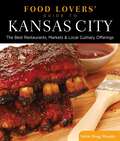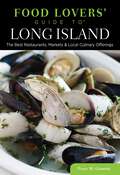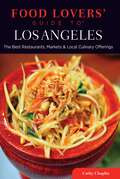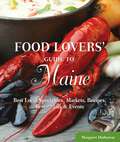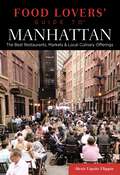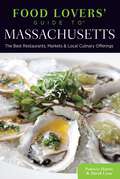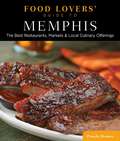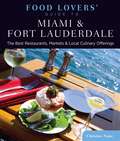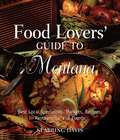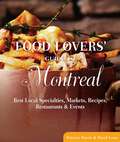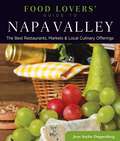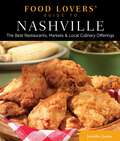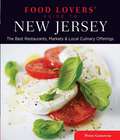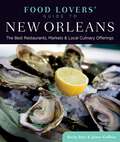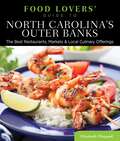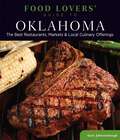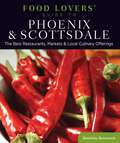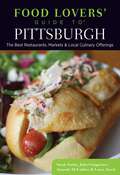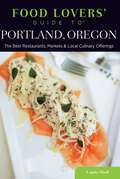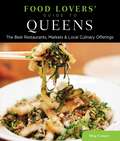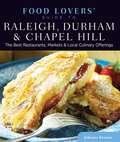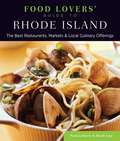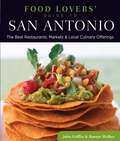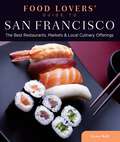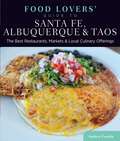- Table View
- List View
Food Lovers' Guide to® Kansas City: The Best Restaurants, Markets & Local Culinary Offerings (Food Lovers' Series)
by Sylvie Hogg MurphyThe ultimate guide to Kansas City's food scene provides the inside scoop on the best places to find, enjoy, and celebrate local culinary offerings. Written for residents and visitors alike to find producers and purveyors of tasty local specialties, as well as a rich array of other, indispensable food-related information including: food festivals and culinary events; specialty food shops; farmers’ markets and farm stands; trendy restaurants and time-tested iconic landmarks; and recipes using local ingredients and traditions.
Food Lovers' Guide to® Long Island: The Best Restaurants, Markets & Local Culinary Offerings (Food Lovers' Series)
by Peter GianottiFood Lovers' GuidesIndispensable handbooks to local gastronomic delights The ultimate guides to the food scene in their respective states or regions, these books provide the inside scoop on the best places to find, enjoy, and celebrate local culinary offerings. Engagingly written by local authorities, they are a one-stop for residents and visitors alike to find producers and purveyors of tasty local specialties, as well as a rich array of other, indispensable food-related information including:• Food festivals and culinary events• Farmers markets and farm stands• Specialty food shops• Places to pick your own produce• One-of-a-kind restaurants and landmark eateries• Recipes using local ingredients and traditions• The best wineries and brewpubs
Food Lovers' Guide to® Los Angeles: The Best Restaurants, Markets & Local Culinary Offerings (Food Lovers' Series)
by Cathy ChaplinThe Best Restaurants, Markets & Local Culinary Offerings The ultimate guides to the food scene in their respective states or regions, these books provide the inside scoop on the best places to find, enjoy, and celebrate local culinary offerings. Engagingly written by local authorities, they are a one-stop for residents and visitors alike to find producers and purveyors of tasty local specialties, as well as a rich array of other, indispensable food-related information including:• Favorite restaurants and landmark eateries• Farmers markets and farm stands• Specialty food shops, markets and products• Food festivals and culinary events• Places to pick your own produce• Recipes from top local chefs • The best cafes, taverns, wineries, and brewpubs
Food Lovers' Guide to® Maine: Best Local Specialties, Markets, Recipes, Restaurants & Events (Food Lovers' Series)
by Margaret HathawaySavor the Flavors of Maine A lobster dinner—the plate piled with steamed clams, corn on the cob, and a cup of drawn butter, followed by a slice of blueberry pie. Maine cuisine? Yes, but it doesn&’t end there. Far from it! Food Lovers&’ Guide to Maine is the definitive contemporary resource to the diverse preferences and palates of the Pine Tree State&’s dynamic food culture. A bounty of mouthwatering delights awaits you in this engagingly written guide.With delectable regional recipes from the renowned kitchens of Maine&’s iconic eateries, diners, and elegant dining rooms, Food Lovers&’ Guide to Maine is the ultimate resource for food lovers to use and savor. Inside You'll Find: • Lobster shacks and fishmongers • Specialty food stores and markets • Farmers&’ markets and farm stands • The Maine Ice Cream Trail • Food festivals and culinary events • Recipes using local ingredients and traditions • The state&’s best wineries, brewpubs, and microbreweries • Cooking classes• Local food lore and kitchen wisdom
Food Lovers' Guide to® Manhattan: The Best Restaurants, Markets & Local Culinary Offerings (Food Lovers' Series)
by Alexis Lipsitz FlippinThe ultimate guide to Manhattan's food scene provides the inside scoop on the best places to find, enjoy, and celebrate local culinary offerings. Written for residents and visitors alike to find producers and purveyors of tasty local specialties, as well as a rich array of other, indispensable food-related information including: food festivals and culinary events; specialty food shops; farmers&’ markets and farm stands; trendy restaurants and time-tested iconic landmarks; and recipes using local ingredients and traditions.
Food Lovers' Guide to® Massachusetts: The Best Restaurants, Markets & Local Culinary Offerings (Food Lovers' Series)
by David Lyon Patricia HarrisThe ultimate guide to the food scene in Massachusetts provides the inside scoop on the best places to find, enjoy, and celebrate local culinary offerings. Written for residents and visitors alike to find producers and purveyors of tasty local specialties, as well as a rich array of other, indispensable food-related information including: food festivals and culinary events; specialty food shops; farmers&’ markets and farm stands; trendy restaurants and time-tested iconic landmarks; and recipes using local ingredients and traditions.
Food Lovers' Guide to® Memphis: The Best Restaurants, Markets & Local Culinary Offerings (Food Lovers' Series)
by Pamela DenneyThe Best Restaurants, Markets & Local Culinary Offerings The ultimate guides to the food scene in their respective states or regions, these books provide the inside scoop on the best places to find, enjoy, and celebrate local culinary offerings. Engagingly written by local authorities, they are a one-stop for residents and visitors alike to find producers and purveyors of tasty local specialties, as well as a rich array of other, indispensable food-related information including:• Favorite restaurants and landmark eateries• Farmers markets and farm stands• Specialty food shops, markets and products• Food festivals and culinary events• Places to pick your own produce• Recipes from top local chefs • The best cafes, taverns, wineries, and brewpubs
Food Lovers' Guide to® Miami & Fort Lauderdale: The Best Restaurants, Markets & Local Culinary Offerings (Food Lovers' Series)
by Christine NajacTwo very different cities. One book. Food is a culture unto itself in Miami, whether it’s Cuban, Italian, burgers, sushi, or steak. The diverse food scene in Miami is simply magical. Fort Lauderdale’s vast culinary landscape is steeped in tradition and the dining scene is vibrant. In Food Lovers’ Guide to Miami & Fort Lauderdale, seasoned food writer Christine Najac shares the inside scoop on the best places to find, enjoy, and celebrate these culinary treasures. A bounty of mouthwatering delights awaits you in this engagingly written guide.With delectable recipes from the renowned kitchens of the city’s iconic eateries, diners, and elegant dining rooms, Food Lovers’ Guide to Miami & Fort Lauderdale is the ultimate resource for food lovers to use and savor. Inside you’ll find:Favorite restaurants • Top waterfront dining and the best hotel cuisine • Specialty food stores, markets, and food trucks • Farmers markets and farm stands • Food festivals and culinary events • Recipes from top Miami & Fort Lauderdale chefs • Cocktails, cafes, taverns, and wine bars • Cooking classes and wine courses • Local food lore and kitchen wisdom
Food Lovers' Guide to® Montana: Best Local Specialties, Markets, Recipes, Restaurants, And Events (Food Lovers' Series)
by Seabring DavisThe essential handbook to the Treasure State's gastronomic delights *The ultimate guide to the food scene in Montana, this book provides the inside scoop on the best places to find, enjoy, and celebrate local culinary offerings. Engagingly written by a local authority, it is a one-stop for residents and visitors alike to find producers and purveyors of tasty local specialties, as well as a rich array of other, indispensable food-related information, including:• Food festivals and culinary events• Farmers&’ markets and farm stands• Specialty food shops• Places to pick your own produce• One-of-a-kind restaurants and landmark eateries• Recipes using local ingredients and traditions• The state&’s best wineries and brewpubs• Cooking schools and seminars• Local food lore, kitchen wisdom, anecdotes, and &“best of&” selections
Food Lovers' Guide to® Montreal: Best Local Specialties, Markets, Recipes, Restaurants & Events (Food Lovers' Series)
by David Lyon Patricia HarrisSavor the flavors of Montreal Yearning for great food in a great city where the day begins with a croissant, a bol of café au lait, and a smile? Look no further than the world&’s second-largest French-speaking city, Montreal. Food Lovers&’ Guide to Montreal is the definitive resource to the best of this city&’s myriad gastronomic delights. From Old Montreal to downtown and Chinatown, from the Latin Quarter, Plateau Mont-Royal, Mile End, and Little Italy to the Eastern Townships, a bounty of mouthwatering delights awaits you in this engagingly written guide.With delectable regional recipes from the renowned kitchens of Montreal&’s iconic bistros, luncheonettes, cafes, brasseries, and elegant dining rooms, Food Lovers&’ Guide to Montreal is the ultimate resource for food lovers to use and savor. Inside You'll Find: Favorite restaurants and landmark eateries • Specialty food stores and markets • Produce markets and farm stands • Food festivals and culinary events • Recipes using local ingredients and traditions • A Quebec wine primer • The city&’s best wine bars and brewpubs, plus regional wineries • Cooking classes • Glossary of French terms
Food Lovers' Guide to® Napa Valley: The Best Restaurants, Markets & Local Culinary Offerings (Food Lovers' Series)
by Jean DoppenbergSavor the Falvors of Napa Valley The heart of California’s wine country, Napa Valley offers diverse and sophisticated options to please the palate. It is home to creative, farm-to-table seasonal menus, cutting-edge chefs, passionate farmers, and innovative purveyors. In Food Lovers’ Guide to Napa Valley, seasoned writer Jean Saylor Doppenberg shares the inside scoop on the best places to find, enjoy, and celebrate these culinary treasures. A bounty of mouthwatering delights awaits you in this engagingly written guide.With delectable recipes from the renowned kitchens of Napa Valley’s iconic eateries, Food Lovers’ Guide to Napa Valley is the ultimate resource for food lovers to use and savor. Inside You'll Find:Favorite restaurants and landmark eateries • Food festivals and culinary events • Recipes from top Napa Valley chefs • Cooking classes • Food and wine pairings with some of Napa’s landmark wineries • The region’s best wine bars, brewpubs, and microbreweries • Farmers’ markets and farm stands • Local food lore and kitchen wisdom • Specialty food stores, markets, and food trucks
Food Lovers' Guide to® Nashville: The Best Restaurants, Markets & Local Culinary Offerings (Food Lovers' Series)
by Jennifer JustusThe Best Restaurants, Markets & Local Culinary Offerings The ultimate guides to the food scene in their respective states or regions, these books provide the inside scoop on the best places to find, enjoy, and celebrate local culinary offerings. Engagingly written by local authorities, they are a one-stop for residents and visitors alike to find producers and purveyors of tasty local specialties, as well as a rich array of other, indispensable food-related information including:• Favorite restaurants and landmark eateries• Farmers markets and farm stands• Specialty food shops, markets and products• Food festivals and culinary events• Places to pick your own produce• Recipes from top local chefs • The best cafes, taverns, wineries, and brewpubs
Food Lovers' Guide to® New Jersey: The Best Restaurants, Markets & Local Culinary Offerings (Food Lovers' Series)
by Peter GenoveseSavor the flavors of New Jersey If there is one thing New Jerseyans are good at, it&’s eating. We&’re equally at home in the poshest restaurant and the most ramshackle seafood shack. We can describe the virtues of filet mignon or a chili cheese dog. We&’ll think nothing of driving 50 miles or more to our favorite restaurant. The Garden State? Call it the Food Fanatic State.In Food Lovers&’ Guide to New Jersey, seasoned food writer Peter Genovese shares the inside scoop on the best places to find, enjoy,and celebrate these culinary treasures. A bounty of mouthwatering delights awaits you in this engagingly written guide.With delectable recipes from the renowned kitchens of the state&’s iconic eateries, diners, and elegant dining rooms, Food Lovers&’ Guide to New Jersey is the ultimate resource forfood lovers to use and savor. Inside You'll Find: Favorite restaurants and landmark eateries • Specialty food stores and markets • Farmers&’ markets and farm stands • Food festivals and culinary events • Recipes from top New Jersey chefs • The state&’s best cafes, taverns, and wine bars • Cooking classes • Local food lore and kitchen wisdom
Food Lovers' Guide to® New Orleans: The Best Restaurants, Markets & Local Culinary Offerings (Food Lovers' Series)
by James Gaffney Becky RetzSavor the Flavors of New Orleans You can&’t keep a great food city down. The jazz is still swinging, the locals are still smiling, and the heart of New Orleans—its restaurants, kitchens, cooks, and the delicious meals they create—is beating stronger than ever before. In Food Lovers&’ Guide to New Orleans, seasoned food writers Becky Retz and James Gaffney share the inside scoop on the best places to find, enjoy, and celebrate these culinary treasures. A bounty of mouthwatering delights awaits you in this engagingly written guide.With delectable recipes from the renowned kitchens of the city&’s iconic eateries, diners, and elegant dining rooms, Food Lovers&’ Guide to New Orleans is the ultimate resource for food lovers to use and savor. Inside You'll Find: Favorite restaurants and landmark eateries • Specialty food stores and markets • Farmers&’ markets and farm stands • Food festivals and culinary events • Recipes from top New Orleans chefs • The city&’s best cafes, taverns, and wine bars• Local food lore and kitchen wisdom
Food Lovers' Guide to® North Carolina's Outer Banks: The Best Restaurants, Markets & Local Culinary Offerings (Food Lovers' Series)
by Elizabeth WiegandFood Lovers' GuidesIndispensable handbooks to local gastronomic delights The ultimate guides to the food scene in their respective states or regions, these books provide the inside scoop on the best places to find, enjoy, and celebrate local culinary offerings. Engagingly written by local authorities, they are a one-stop for residents and visitors alike to find producers and purveyors of tasty local specialties, as well as a rich array of other, indispensable food-related information including:• Food festivals and culinary events• Farmers markets and farm stands• Specialty food shops• Places to pick your own produce• One-of-a-kind restaurants and landmark eateries• Recipes using local ingredients and traditions• The best wineries and brewpubs
Food Lovers' Guide to® Oklahoma: The Best Restaurants, Markets & Local Culinary Offerings (Food Lovers' Series)
by Katie JohnstonbaughThe Best Restaurants, Markets & Local Culinary Offerings The ultimate guides to the food scene in their respective states or regions, these books provide the inside scoop on the best places to find, enjoy, and celebrate local culinary offerings. Engagingly written by local authorities, they are a one-stop for residents and visitors alike to find producers and purveyors of tasty local specialties, as well as a rich array of other, indispensable food-related information including:• Favorite restaurants and landmark eateries• Farmers markets and farm stands• Specialty food shops, markets and products• Food festivals and culinary events• Places to pick your own produce• Recipes from top local chefs • The best cafes, taverns, wineries, and brewpubs
Food Lovers' Guide to® Phoenix & Scottsdale: The Best Restaurants, Markets & Local Culinary Offerings (Food Lovers' Series)
by Katarina KovacevicSavor the Flavors of Phoenix & ScottsdaleThings are different in the desert, and we wouldn&’t have it any other way. Greater Phoenix offers everything from sophisticated, delectable dishes to simple Southwest staples paired with a proud Old West attitude. In Food Lovers&’ Guide to Phoenix & Scottsdale, seasoned food writer Katarina Kovacevic shares the inside scoop on the best places to find, enjoy, and celebrate these culinary treasures. A bounty of mouthwatering delights awaits you in this engagingly written guide.With delectable recipes from the renowned kitchens of the region&’s iconic eateries, diners, and elegant dining rooms, Food Lovers&’ Guide to Phoenix & Scottsdale is the ultimate resource for food lovers to use and savor.Inside You'll Find:Favorite restaurants and landmark eateries • Farmers&’ markets and farm stands • Specialty food stores, markets, and food trucks • Food festivals and culinary events • Recipes from top Phoenix and Scottsdale chefs • The cities&’ best cafes, taverns, and wine bars • The metro area&’s best breweries, wineries, and wine shops
Food Lovers' Guide to® Pittsburgh: The Best Restaurants, Markets & Local Culinary Offerings (Food Lovers' Series)
by Laura Zorch Sarah Sudar Julia Gongaware Amanda McfaddenFood Lover's Guide to Pittsburgh is the ultimate guide to the city's food scene and provides the inside scoop on the best places to find, enjoy, and celebrate local culinary offerings. Engagingly written by local foodies, this guide is a one-stop resource for residents and visitors alike to find producers and pureyors of tasty local specialities, as well as a rich array of other, indispensible food-related information including:One-of-a-kind restaurants and landmark eateriesSpeciality food shopsThe city's best bakeriesLocal drink sceneFood festivals and culinary eventsRecipes from top Pittsburgh chefs
Food Lovers' Guide to® Portland, Oregon: The Best Restaurants, Markets & Local Culinary Offerings (Food Lovers' Series)
by Laurie WolfThe ultimate guide to the Portland, Oregon food scene provides the inside scoop on the best places to find, enjoy, and celebrate local culinary offerings. Written for residents and visitors alike to find producers and purveyors of tasty local specialties, as well as a rich array of other, indispensable food-related information including: food festivals and culinary events; specialty food shops; farmers&’ markets and farm stands; trendy restaurants and time-tested iconic landmarks; and recipes using local ingredients and traditions.
Food Lovers' Guide to® Queens: The Best Restaurants, Markets & Local Culinary Offerings (Food Lovers' Series)
by Meg CotnerThe Best Restaurants, Markets & Local Culinary Offerings The ultimate guides to the food scene in their respective states or regions, these books provide the inside scoop on the best places to find, enjoy, and celebrate local culinary offerings. Engagingly written by local authorities, they are a one-stop for residents and visitors alike to find producers and purveyors of tasty local specialties, as well as a rich array of other, indispensable food-related information including:• Favorite restaurants and landmark eateries• Farmers markets and farm stands• Specialty food shops, markets and products• Food festivals and culinary events• Places to pick your own produce• Recipes from top local chefs • The best cafes, taverns, wineries, and brewpubs
Food Lovers' Guide to® Raleigh, Durham & Chapel Hill: The Best Restaurants, Markets & Local Culinary Offerings (Food Lovers' Series)
by Johanna KramerFood Lovers' GuidesIndispensable handbooks to local gastronomic delights The ultimate guides to the food scene in their respective states or regions, these books provide the inside scoop on the best places to find, enjoy, and celebrate local culinary offerings. Engagingly written by local authorities, they are a one-stop for residents and visitors alike to find producers and purveyors of tasty local specialties, as well as a rich array of other, indispensable food-related information including:• Food festivals and culinary events• Farmers markets and farm stands• Specialty food shops• Places to pick your own produce• One-of-a-kind restaurants and landmark eateries• Recipes using local ingredients and traditions• The best wineries and brewpubs
Food Lovers' Guide to® Rhode Island: The Best Restaurants, Markets & Local Culinary Offerings (Food Lovers' Series)
by David Lyon Patricia HarrisFood Lovers' GuidesIndispensable handbooks to local gastronomic delights The ultimate guides to the food scene in their respective states or regions, these books provide the inside scoop on the best places to find, enjoy, and celebrate local culinary offerings. Engagingly written by local authorities, they are a one-stop for residents and visitors alike to find producers and purveyors of tasty local specialties, as well as a rich array of other, indispensable food-related information including:• Food festivals and culinary events• Farmers markets and farm stands• Specialty food shops• Places to pick your own produce• One-of-a-kind restaurants and landmark eateries• Recipes using local ingredients and traditions• The best wineries and brewpubs
Food Lovers' Guide to® San Antonio: The Best Restaurants, Markets & Local Culinary Offerings (Food Lovers' Series)
by Bonnie Walker John GriffinFood Lovers' GuidesIndispensable handbooks to local gastronomic delights The ultimate guides to the food scene in their respective states or regions, these books provide the inside scoop on the best places to find, enjoy, and celebrate local culinary offerings. Engagingly written by local authorities, they are a one-stop for residents and visitors alike to find producers and purveyors of tasty local specialties, as well as a rich array of other, indispensable food-related information including:• Food festivals and culinary events• Farmers markets and farm stands• Specialty food shops• Places to pick your own produce• One-of-a-kind restaurants and landmark eateries• Recipes using local ingredients and traditions• The best wineries and brewpubs
Food Lovers' Guide to® San Francisco: The Best Restaurants, Markets & Local Culinary Offerings (Food Lovers' Series)
by Grace KehSavor the Flavors of San FranciscoWith more restaurants per capita than any other city in the country, the City by the Bay offers its hungry locals and visitors a bountiful feast of delicious dining experiences, from succulent, high-grade sushi and piping-hot bowls of pho to thick, juicy cuts of prime rib served with sourdough bread. In Food Lovers&’ Guide to San Francisco, seasoned food writer Grace Keh shares the inside scoop on the best places to find, enjoy, and celebrate these culinary treasures. A bounty of mouthwatering delights awaits you in this engagingly written guide.With delectable recipes from the renowned kitchens of the city&’s iconic eateries, diners, and elegant dining rooms, Food Lovers&’ Guide to San Francisco is the ultimate resource for food lovers to use and savor.Inside You'll Find:Favorite restaurants and landmark eateries • Specialty food stores and markets • Farmers&’ markets and farm stands • Food festivals and culinary events • Recipes from top San Francisco chefs • The city&’s best cafes, taverns, and wine bars • Cooking classes • Local food lore and kitchen wisdom
Food Lovers' Guide to® Santa Fe, Albuquerque & Taos: The Best Restaurants, Markets & Local Culinary Offerings (Food Lovers' Series)
by Andrea FeuchtThe Best Restaurants, Markets & Local Culinary Offerings The ultimate guides to the food scene in their respective states or regions, these books provide the inside scoop on the best places to find, enjoy, and celebrate local culinary offerings. Engagingly written by local authorities, they are a one-stop for residents and visitors alike to find producers and purveyors of tasty local specialties, as well as a rich array of other, indispensable food-related information including:• Favorite restaurants and landmark eateries• Farmers markets and farm stands• Specialty food shops, markets and products• Food festivals and culinary events• Places to pick your own produce• Recipes from top local chefs • The best cafes, taverns, wineries, and brewpubs
